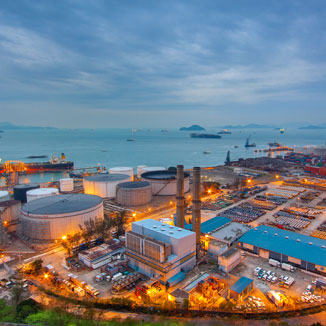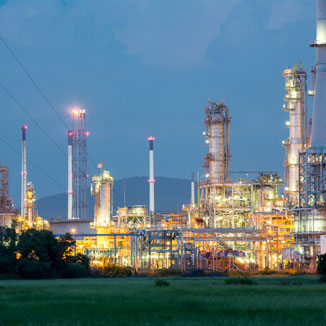
Facility Siting: Risk-Based Solutions and Benefits
Discover a risk-based approach to facility siting and the benefits it can provide for understanding your on-site risks.Read More

Quantitative Risk Analysis/Assessment is a methodology for the quantification of risk and can be used to assess multiple hazard types across the Oil, Gas and Chemical, Power and Energy and Marine and Offshore industries. Quantitative Risk Assessments use the consequence and frequency of events to gain a more accurate understanding of the likelihood of an incident, providing organizations a more realistic insight into the threats they actually face, and enabling them to design mitigation plans accordingly.
Around the world, there are many different drivers for the quantification of risk, from external regulatory bodies to internal corporate standards. However, by quantifying your risk it is easier to tackle recommendations, rank mitigations and gives you more flexibility to come up with a remediation plan. A Quantitative Risk Assessment can be used in supporting evidence to demonstrate acceptable risk levels and identify the options for risk reduction.

Step one involves identifying risks through qualitative methods such as HAZOP, LOPA, HAZID, and converting them into exposure and vulnerabilities. Consequence analysis techniques can be used to model release rates, quantities and dispersion of released materials associated with fires, explosions and other facility-specific hazards and estimate the potential impact of these events on employees, the public, facility property, neighboring facilities and the environment.
Typical results include identification of the areas potentially affected by these events, as well as estimates of casualties, economic losses and environmental impacts. By adding the frequency to these consequences, you can gain a realistic understanding of your exposure and vulnerability to hazardous events. Our experts in Knoxville have spent decades working on scenario and frequency development, having written textbooks on frequency rates published by CCPS.
The next phase in the journey to understanding risk is using a mixture of prior site data and risk databases, our team of experts can calculate a unique risk frequency specifically for your site. To analyze that risk, a mixture of modeling and simulation tools and complex mathematical formulas are used, providing you with both individual and aggregate risk. Once you have an understanding of the impact of the risks to your facility, staff and operations, you can evaluate this risk against company and regulatory acceptance levels and perform cost-benefit analysis to start preparing your mitigation strategy.
One main benefit of Quantitative Risk Analysis is that it identifies the controlling risk sources. Since scenarios are developed across the process, risk results are ranked by scenario to indicate which processes provide the highest risk and are good candidates for risk reduction via process controls and hazard mitigation. We identify individual risk for each scenario and aggregate risk (in the form of risk indices) by scenario and hazard type. Targeted mitigation, occupancy changes and physical changes to the building can support organizations to significantly reduce the risk profile.
Facility Assessment and Consequence Evaluation Tool (FACET3D) is a software code that combines blast load prediction and building damage modeling into a quick-running tool for engineers, security analysts and site planners. FACET3D models high explosive and vapor cloud explosions and predicts the overpressures and damage to surrounding objects. Results are displayed in a 3D graphical environment. Additional versions and applications of this software include FACET Viewer, FACET-FGS (Fire Gas Simulation) and FACET-AT (Anti-Terrorism).


Whether you are a shipyard, ship operator, or manufacturer, Quantitative Risk Assessments (QRA) are used as a means to demonstrate regulatory compliance to achieve classification, comply with the IMO regulations and achieve international corporate standards. A standard risk program would involve risk identification, followed by a QRA before developing risk management and mitigation plans. For vessels over 15 years, additional assessments must be completed every 3 years to review the safety and integrity of the vessel.
Featured Experience:
View More

In the offshore markets, the requirements for QRAs are benchmarked against internal company requirements and Health and Safety Executive (HSE) guidelines. QRAs must be repeated should any changes occur to the plant as they could affect the permits to operate and covers clients should they fall into issues while operating. ABS Group has been using spreadsheets, formulas for individual and aggregate risk and commercial software to assess and produce recommendations for the risks that exceed the benchmarks set by the regulators for over 20 years.
Featured Experience
View More

A risk-based methodology (QRAs) can be used to meet the facility siting regulations as well as other internal company standards within the onshore oil, gas and chemical industries. While more costly than the traditional consequence-based approach, it provides more information on which scenarios are driving the outcomes and can reduce the impact of high consequence, low-frequency scenarios. Unlike the offshore market where spreadsheets are used to calculate the risk, this can be limiting for the onshore industries. Therefore, ABS Group utilizes it’s proprietary software FACET3D, developed by one of our own engineers in San Antonio, to combine blast load predictions and building damage to produce results in a 3D graphical environment.
Featured Experience
View More

COMAH and Seveso regulations require organizations to complete risk-based assessments to identify and mitigate the risks to staff, facilities and the environment. Our structural, chemical and security professionals in our Warrington office have experience supporting onshore oil, gas and chemical facilities to perform occupied building risk assessments, blast mitigation analysis studies and other risk-based assessments across Europe and the Middle East.
Featured Experience:
Refineries
View More

Within the Nuclear industries around the world, probabilistic risk assessments are used to quantitatively estimate the likelihood and consequence of both operational and natural hazards events happening as part of the Safety Case assessments required by the relevant regulator. ABS Group has been supporting the nuclear industries for over 50 years with safety case assessments, periodic reviews, and site walkdowns. Our experts deliver high-quality reports to support organizations and regulatory bodies.
Featured Experience:
View More
Once you have your QRA, it's time to build cost-effective mitigation plans. Targeted mitigation has a significant risk reduction impact across the facility using these results. Examples of these mitigation measures include:
Other forms of risk reduction occur on the building side. First, occupancy changes can be performed to reduce risk by moving personnel to other locations. Physical changes to the building in the form of retrofits to increase blast and fire resistance, additional PPE to reduce the consequences of evacuation or shelter in place, and administrative changes such as keeping roll-up doors closed to prevent flammable vapor infiltration can all further reduce the risk to occupants.
QRAs can encompass a large variety of methodologies and results output. ABS Group believes in a targeted solution for each and every client’s unique needs and requirements, customizing the approach/method based on the immediate concerns of the organization. We have successfully supported clients around the world to understand and mitigate their risk to As Low As Reasonably Practicable (ALARP).



Freedom and flow of good quality information between client and consultant is crucial to performing a good quality QRA. For legacy sites, some information may need to be digitized and brought up to date before the QRA can commence. Our expert Process Safety, Civil and Structural Engineers are available to support each client with their unique needs to achieve the desired outcome.
What makes a good QRA?
A QRA is an acceptable methodology for use in a facility siting study. The other common methodology is the consequence approach. A QRA evaluates the consequences and frequency of hazards to occupied buildings with the goal of calculating the risk to building occupants. QRA requires a company risk criterion for evaluating results. In contrast, a consequence approach does not directly consider the frequency of the releases but rather includes maximum credible events (MCEs) in the study and evaluates buildings based on criteria such as acceptable blast damage or thermal exposure.
What is the difference between a Quantitative Risk Assessment (QRA) and a Facility Siting Study?
Probabilistic Risk Assessments or Quantitative Risk Assessments are used interchangeably in different industries around the world. The nuclear industry's preference is for Probabilistic Risk Assessment, whereas the oil, gas and chemical markets use Quantitative Risk Assessments. Whilst the output requirements for these sectors are slightly different, both studies involve a systematic assessment of the consequence and frequency of a potential event to develop an understanding of individual and aggregate risk.
What is the difference between a Quantitative Risk Assessment and a Probabilistic Risk Assessment?